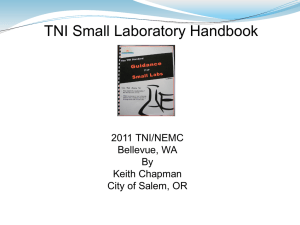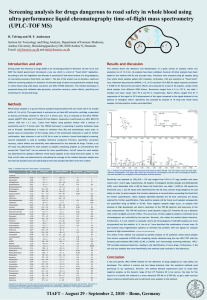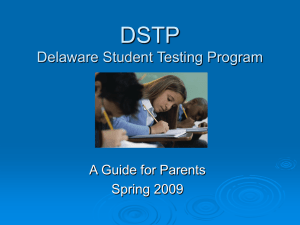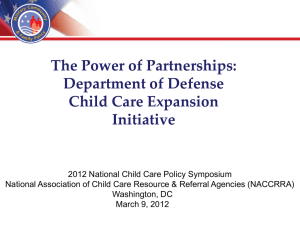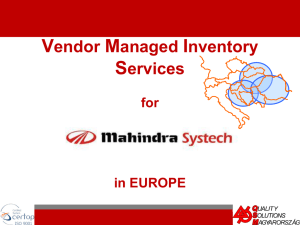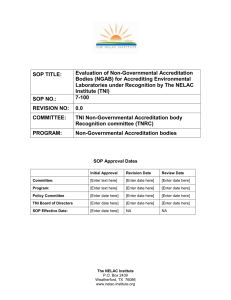Virtual Chemist - CLU-IN
advertisement
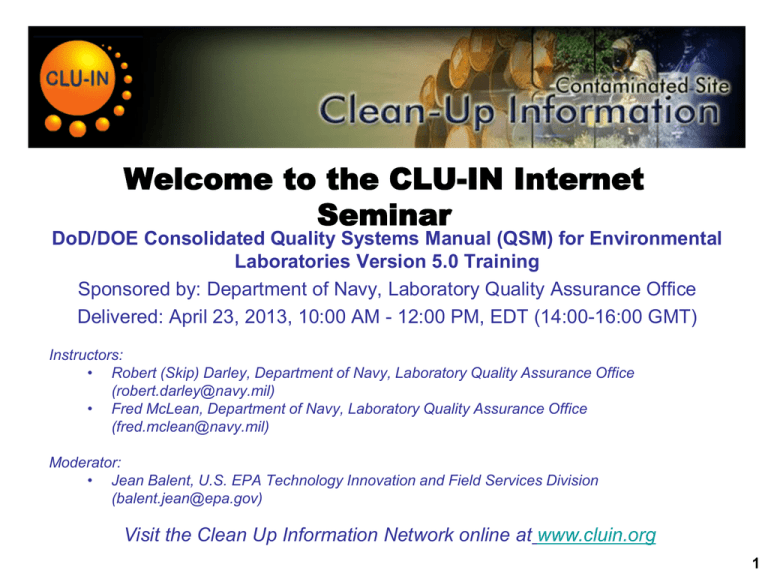
Welcome to the CLU-IN Internet Seminar DoD/DOE Consolidated Quality Systems Manual (QSM) for Environmental Laboratories Version 5.0 Training Sponsored by: Department of Navy, Laboratory Quality Assurance Office Delivered: April 23, 2013, 10:00 AM - 12:00 PM, EDT (14:00-16:00 GMT) Instructors: • Robert (Skip) Darley, Department of Navy, Laboratory Quality Assurance Office (robert.darley@navy.mil) • Fred McLean, Department of Navy, Laboratory Quality Assurance Office (fred.mclean@navy.mil) Moderator: • Jean Balent, U.S. EPA Technology Innovation and Field Services Division (balent.jean@epa.gov) Visit the Clean Up Information Network online at www.cluin.org 1 Seminar Homepage Join the seminar online Download Slides Feedback 2 Housekeeping • Entire broadcast offered live via Adobe Connect – participants can listen and watch as the presenters advance through materials live – Some materials may be available to download in advance, you are recommended to participate live via the online broadcast • Audio is streamed online through by default – Use the speaker icon to control online playback – If on phones: all lines will be globally muted • Q&A – use the Q&A pod to privately submit comments, questions and report technical problems • This event is being recorded and shared via email shortly after live delivery • Archives accessed for free http://cluin.org/live/archive/ 3 New online broadcast screenshot Enlarge presentation Control online audio View presentation live online here Submit private questions, comments or report technical problems Information about Sponsors & Speakers 4 DoD/DOE QSM TRAINING April 2013 Fred McLean Navy Laboratory Quality & Accreditation Office Chair, DoD Quality Assurance Oversight Subgroup 5 DoD / DOE QSM DoD / DOE QSM title page: A “stand-alone” document has been created that also requires ISO 17025:2005(E) & TNI Standard Volume 1 (Sept. 2009) for full compliance. Tentative title: DoD/DOE Consolidated Quality Systems Manual for Environmental Laboratories Subtitled: DoD QSM Version 5.0 & DOE QSAS Version 3.0 For today’s training, the new standard will be referred to as the “QSM” 6 Module 1 Proficiency Testing Proficiency Testing Module 1 REPLACES the NELAC Module 1 text; QSM PT text (Box 43) in Quality Systems has been deleted Requires PT samples from ISO-17043 providers. Requires PT samples for all analytes that are on a scope of accreditation. Requires PT samples twice a year – except for Toxicity testing (once per year). Requires that acceptance/Failure based on program(s) participated in by the PT provider. Requires Mixed Analyte Performance Evaluation Program (MAPEP) for radiochemistry samples for DOE. Since those providers are also ISO-17043 accredited, they are allowed for DoD. Allows exceptions (in writing to AB) when non-ISO 17043 PTs are the only available options or no PTs are available. 7 Module 2 Quality Systems General Quality Systems: Global All DoD/DOE text is marked as Requirements, Clarifications (of TNI text) or Guidance. Requirement and Clarification text is mandatory for labs seeking or maintaining DoD-ELAP accreditation. Text will be “in addition to”, “in lieu of”, or clarification of existing text. Text will refer to either: ISO clauses or TNI text. Text referencing Safety & Rad Health are DOE ONLY. Assessor will need access to both ISO 17025:2005 and TNI Standard (Sept. 2009). 8 Module 2 Quality Systems General Quality Systems Global Changes – Based on review feedback Removed Terms “illegal” and “fraudulent” and replaced with “unethical” and “inappropriate” Changed “client” to “customer” Changed “documents” to “records” Changed “corrective action” to “corrections” Findings can be neutral as well as positive or negative Clarified electronic data as being acceptable – i.e. electronic signatures 9 Module 2 Quality Systems General Quality Systems 4.0 Technical Qualifications for Directors, Analysts deleted from QSM VERSION 5.0. 4.3.2.2 ISO additions in Document Control g) Reviews (internal/external) of management systems documentation must be available for assessment. h) ANY documents providing instructions to lab personnel (e.g. operator aids) are considered part of the management system and are subject to document control procedures. 4.5.5 TNI additions in Subcontracting 4.5.7 Subcontracting in support of environmental restoration projects must be accredited in accordance with DoD-ELAP. 4.5.10 Subcontracted elements of the lab’s QS (such as data review) must comply with the requirements of the QSM and are subject to review/approval by customer. 10 Module 2 Quality Systems General Quality Systems 4.7.1 ISO additions in Service to Client a) Thru d) is now a requirement for feedback from the customer; specified obsolete/incorrect methods, method modifications needed to meet objectives, Project Planning documents missing/need clarification, and problems with sampling/analysis that may impact results. 4.11.8 ISO/TNI additions to Corrective Action Approved corrective actions developed to address findings during DoD-ELAP or DOECAP assessments must be implemented. Any changes to approved corrective action plans must be approved by the DoD-ELAP Accreditation Bodies or the DOECAP Operations Team, as appropriate. Guidance added: willful avoidance of approved corrective action plans may lead to loss of work. 11 Module 2 Quality Systems Technical Requirements 5.3.3.b Cross-contamination ISO Clause addition: Storage Blanks analyzed at a minimum of every 14 days. 5.4.6 Uncertainty TNI addition: Language from QSM 4.2 preface section 5.4.6.1 (TNI language) added back. 5.4.7.2 Control of Data ISO addition: Sections d) thru k) added for data security of LIMS systems within the laboratory. 5.5.13.1 Support Equipment addition to Table: Glass microliter syringes need general certificate of bias/precision. 5.6 Measurement Traceability ISO addition: ISO clauses 5.6.1 and 5.6.2 added back into standard as applicable. 12 Module 2 Quality Systems Technical Requirements 5.6.4.2 Labeling of standards Expiration dates – will follow the TNI standard; if the manufacturer does not assign a date, it will not be required. 5.8.8 & 5.8.9 d) and e) Legal Chain of Custody Protocols for legal C-O-C added, WHERE APPLICABLE. 5.10 Reporting Invokes Appendix A for reporting results unless superseded by client. 6.0 Radioactive Materials Management This entire section is DOE ONLY 13 Module 3 Asbestos Testing 1.6.2.2.e Demonstration of Capability (DOC) Option i) is not allowed (correcting the source of the problem first). Option ii) allowed (repeat the test). 1.7.1.2.2 Microscope phase shift detection limit checked monthly Changed to daily and after modification. 1.7.1.3.1 Polarized light microscope alignment Added section a) thru c) give detail into aligning and documenting microscope. 14 Module 4 Chemistry Testing 1.5.2.1.f LOD/LOQ in lieu of TNI Each preparation method listed on the scope of accreditation must have quarterly LOD/LOQ verifications. In situations where methods are setup and used on an infrequent basis, the laboratory may choose to perform LOD/LOQ verifications on a one per batch basis. All verification data will be in compliance, reported, and available for review. Not all possible combinations of preparation and cleanup techniques are required to have LOD/LOQ verifications. However, if LOD/LOQ verifications are not performed on all combinations, the laboratory must base the LOD/LOQ verifications on the worst case basis (preparation method with all applicable cleanup steps). After each DL determination, the laboratory must establish the LOD by spiking a quality system matrix at a concentration of at least two to no greater than 4 times the DL. This spike concentration establishes the LOD and the concentration at which the LOD shall be verified. 15 Module 4 Chemistry Testing 1.7.1.1.d Second Sources in lieu of TNI The use of a standard from a second lot obtained from the same manufacturer (independently prepared from different source materials) is acceptable for use as a second source standard. 1.7.2.e CCV in lieu of 1.7.2.e If a CCV fails, the laboratory can immediately analyze two additional consecutive CCVs (immediately is defined as within one hour). This approach allows for spurious failures of analytes to be reported without reanalysis of samples. Any corrective actions that change the dynamics of the system (e.g., clip column, clean injection port, run blanks) requires that all samples since the last acceptable CCV be reanalyzed. Both of these CCVs must meet acceptance criteria in order for the samples to be reported without reanalysis. If either of these two CCVs fail or if the laboratory cannot immediately analyze two CCVs, the associated samples cannot be reported and must be reanalyzed. Corrective action(s) and recalibration must occur if the above scenario fails. All affected samples since the last acceptable CCV must be reanalyzed. Flagging of data for a failed CCV is only appropriate when the affected samples cannot be reanalyzed. The laboratory must notify the client prior to reporting data associated with a failed CCV. 16 Module 4 Chemistry Testing 1.7.3.2.3 LCS in lieu of 1.7.3.2.3.b d) Control limits shall be monitored on an on-going basis (at least quarterly) for shifts in mean recovery, changes in standard deviation, and development of trends. Laboratories may choose representative compounds for control charts for the purpose of trend analysis. f) A laboratory must use its in-house statistically established LCS control limits for the purpose of trend analysis and may use in-house control limits as a component in estimating measurement uncertainty. g) In the absence of client specified LCS reporting criteria, the LCS control limits outlined in the DoD/DOE QSM Appendix C tables shall be used when reporting data for DoD/DOE projects. Laboratories must develop processes or procedures to incorporate these limits. 17 Module 4 Chemistry Testing 1.7.3.2.3 LCS in lieu of 1.7.3.2.3.b h) The LCS limits specified in the DoD/DOE QSM Appendix C tables shall be used for batch control unless project specific criteria exist. Sporadic marginal exceedances are allowed for those analytes outside the 3 standard deviation control limits but still within 4 standard deviations. Marginal exceedances are not allowed for those analytes determined by a project to be target analytes (i.e. “risk drivers”) without project specific approval. i) For analytes that are not listed in the DoD/DOE QSM Appendix C control limits tables, a laboratory shall use their in-house control limits for batch control and data reporting. j) DoD Only (Requirement) For DoD-ELAP accreditation, a laboratory must develop in-house control limits for all analytes on their scope of accreditation. Inhouse control limits shall be used for trend analysis, and batch control for those analytes not listed in the DoD/DOE QSM Appendix C LCS tables. 18 Module 4 Chemistry Testing 1.7.3.6 Confirmation columns a) HPLC UV-Diode Array detectors are not considered confirmation for a UV detector. 1.7.4.2 Marginal Exceedances The following shall be implemented in addition to TNI 1.7.4.2 b): Sporadically Marginal Exceedances are not allowed for target analytes (chemicals of concern as identified by a project) without project-specific approval. 1.7.4.2 DoD/DOE (Guidance) Target analytes are considered those few analytes that are critical for the success of a project (such as risk drivers) where sporadic marginal exceedances cannot be allowed. Laboratories should consult with clients whenever long lists of analytes are requested for analysis to determine if marginal exceedances will not be allowed. 19 Modules 5,6, & 7 Microbiological Testing Module 5: No changes to TNI language. Radiochemistry Testing Module 6: This DoD/DOE module references the radiochemical terms, definitions, and requirements contained in the 2009 TNI Standard Module 6 Quality Systems for Radiochemical Testing. However, it does not preclude the use of other terms, definitions, and requirements from the consensus document Multi-Agency Radiological Laboratory Analytical Protocols (MARLAP) Manual, July 2004. Toxicity Testing Module 7: No changes to TNI language. 20 Appendix A Reporting Requirements; new section 7.0 When third party review or data validation is to be performed, the extent (stage) of data validation that can be performed is dependent upon the type (level) of data report delivered by the laboratory. The data report level and data validation stage required to meet project data quality objectives should be specifically defined in the QAPP. The minimum reporting requirements for each level of data report are outlined below. A cover sheet, table of contents, and case narrative including all of the information specified in the above sections are required for all levels of data reports. Level 1: Analytical results, Sample Management Records. Level 2: Level 1 reporting requirements plus QA/QC Information, Instrument QA/QC Information, Instrument and Preparation logs. Level 3: Level 2 reporting requirements plus Instrument Quantitation Reports. Level 4: Level 3 reporting requirements plus Instrument Chromatograms and Spectra. In addition, Standards traceability should be included in Levels 3 and 4 if a legal chain of custody is required. The data validation guidelines established in other Department of Defense/Department of Energy guidance or project-specific guidelines may have distinct reporting formats. The appropriate QAPP should be consulted to determine what type of data package is required. 21 Appendix B Quality Control Tables 19 Tables are now a part of QSM Version 5.0; Redundant information was eliminated: Demonstration of Capability (DOC), LOD/LOQ determination, Reporting between DL and LOD Eliminated method listings, now referenced by technology (except 8330B and 8280/8290) Split AA from ICP; HPLC from GC and 8330B New Tables created: CWA, perfluorinated compounds, alpha spectroscopy, gamma spectroscopy, gas flow counting, liquid scintillation 22 Appendix B Quality Control Tables Grinding Blanks for Method 8330B – Grinding Blanks shall be collected prior to analysis; after every 10 samples; and at the end of the batch in lieu of between every sample. At least one grinding blank per batch must be analyzed (thus, all grinding blanks can be composited). Ban on “force through zero” removed. Allowed, IF APPLICABLE. Surrogates – second source for surrogates are not required, but LOD and LOQ verifications are still required. ICV and CCV – ICV is as stringent as the CCV. Organic GC/MS methods are required to have an “end of run” CCV at ±50%. 23 Appendix C LCS Tables 23 methods with solid, water, and gas matrices represented. Analytes ≤15% recovery or ≥25% RSD were removed from the tables. No adjustments made to the limits other than to round off to nearest whole number. A laboratory must use the QSM Appendix C Limits for batch control if project limits are not specified. If the analyte(s) are not listed, use in-house LCS limits if project limits are not specified. 24 Conclusion Implementation Plans How will Questions on the new DoD/DOE QSM be addressed? Questions generated by this CLU-IN session and any others will be reviewed by the DoD/DOE quality system subgroup and answered. The following website will have all the responses: http://www.denix.osd.mil/edqw/ This is an open website that also has contact information that will allow anyone to send in questions on the new QSM. New Ways to stay connected! • www.cluin.org • Follow CLU-IN on Facebook, LinkedIn, or Twitter https://www.facebook.com/EPACleanUpTech https://twitter.com/#!/EPACleanUpTech http://www.linkedin.com/groups/Clean-UpInformation-Network-CLUIN-4405740 26 Resources & Feedback • To view a complete list of resources for this seminar, please visit the Additional Resources • Please complete the Feedback Form to help ensure events like this are offered in the future Need confirmation of your participation today? Fill out the feedback form and check box for confirmation email. 27
